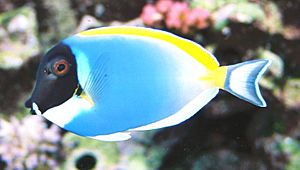Acanthuroidei facts for kids
Quick facts for kids Acanthuroidei |
|
|---|---|
 |
|
| A powderblue surgeonfish | |
| Scientific classification | |
| Kingdom: | |
| Phylum: | |
| Class: | |
| Order: | |
| Suborder: |
Acanthuroidei
|
Acanthuroidei is a group of fish that are part of a larger order called Perciformes. Perciformes is actually the biggest group of fish in the world! These fish are often found in warm, tropical waters, especially around coral reefs.
Fish in the Acanthuroidei suborder have a unique look. They usually have a body that is taller than it is wide, almost like a pancake standing on its side. Their bodies are covered with many small scales. The name "Acanthuroidei" comes from the surgeonfish family, which is a well-known group within this suborder. The word "Acanthurus" comes from two Greek words: akantha, meaning "thorn," and oura, meaning "tail." This name is a big clue about a special feature many of these fish have!
Contents
What are Acanthuroidei?
Acanthuroidei is a "suborder," which is like a smaller family group within a much larger family. The bigger family is called Perciformes, and it includes over 10,000 different kinds of fish, from tuna to perch! So, Acanthuroidei are a special branch of this huge fish family tree.
These fish are known for their flat, oval-shaped bodies and often bright colors. Many of them live in the ocean, especially in coral reefs, which are like underwater cities full of life. They play an important role in keeping these reefs healthy.
Types of Fish in This Group
The most famous fish in the Acanthuroidei suborder are the surgeonfish. You might know them from movies or aquariums!
- Surgeonfish (family Acanthuridae): These fish get their name from a super cool and unique feature: they have sharp, scalpel-like spines on the sides of their tails. These spines are usually folded down, but they can stick out when the fish needs to defend itself. It's like having a built-in pocket knife! Surgeonfish come in many beautiful colors and patterns.
- Rabbitfish (family Siganidae): These fish have small, rabbit-like mouths and venomous spines on their fins. They are often found grazing on algae in coral reefs.
- Spadefish (family Ephippidae): These fish have very tall, flat bodies that look a bit like a spade or a shovel. They often swim in schools and can be found in both reefs and open water.
Where Do They Live?
Most fish in the Acanthuroidei group live in warm, tropical parts of the world's oceans. They love places like the coral reefs of the Pacific Ocean, Indian Ocean, and the Caribbean Sea. Coral reefs provide them with plenty of food, places to hide from predators, and safe spots to lay their eggs. Some species can also be found in rocky areas or seagrass beds.
What Do They Eat?
Many fish in this suborder are herbivores, meaning they mostly eat plants.
- Algae Eaters: Surgeonfish, for example, spend a lot of their time nibbling on algae that grows on rocks and corals. This is really important for the reef because it stops the algae from growing too much and covering the corals.
- Plankton Eaters: Some species also eat tiny floating organisms called plankton.
- Omnivores: A few might eat a mix of algae and small invertebrates.
How Do They Protect Themselves?
Fish in the Acanthuroidei group have different ways to stay safe from predators:
- Tail Spines: As mentioned, surgeonfish have their famous "scalpels" on their tails. If a bigger fish tries to eat them, they can use these sharp spines to defend themselves.
- Venomous Spines: Rabbitfish have spines on their fins that can deliver a mild venom. This makes predators think twice before trying to eat them.
- Schooling: Many of these fish swim in large groups called schools. There's safety in numbers! It's harder for a predator to pick out one fish from a big group.
- Camouflage: Some species have colors and patterns that help them blend in with their surroundings, making them harder to spot.
Why Are They Important?
These fish are super important for the health of coral reefs. By eating algae, they help keep the corals clean and healthy, allowing them to grow and thrive. Without them, algae could overgrow and harm the delicate coral ecosystems. They are also a beautiful part of the ocean's biodiversity, making reefs vibrant and exciting places to explore.
See also
 In Spanish: Acanthuroidei para niños
In Spanish: Acanthuroidei para niños

